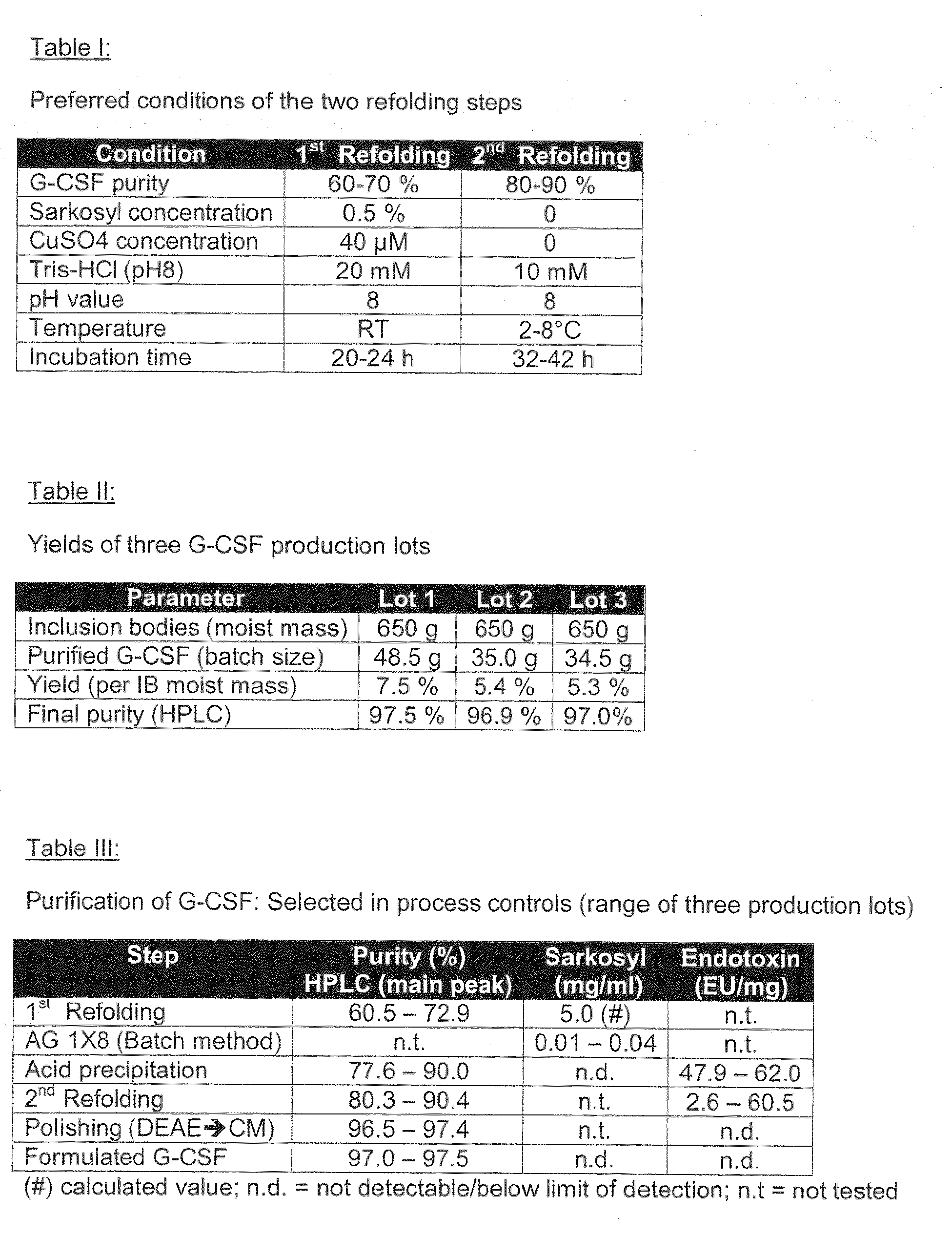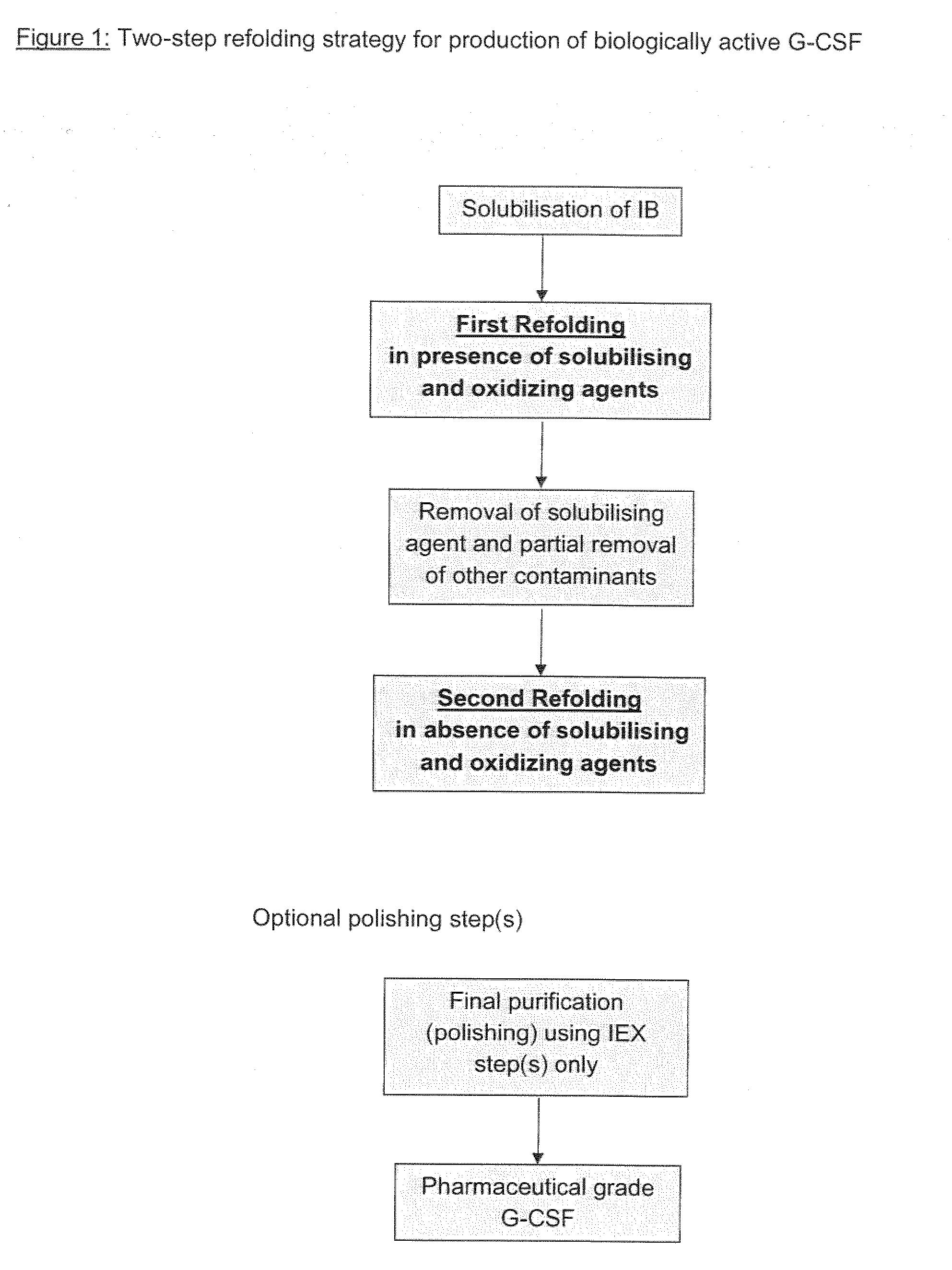Methods for refolding g-csf from inclusion bodies
- Summary
- Abstract
- Description
- Claims
- Application Information
AI Technical Summary
Benefits of technology
Problems solved by technology
Method used
Image
Examples
example 1
Fermentation and Expression
[0266]The G-CSF (filgrastim) was produced with the recombinant E. coli C2523 T7 pol pRG / GCSFa clone (E. coli transformed with an expression vector comprising G-CSF). Under aseptic conditions the prepared seed culture media was inoculated with 0.10-0.15 cm3 cell suspensions obtained from a thawed working cell bank vial that was stored in liquid nitrogen. The inoculated seed culture flasks were incubated in a gyratory shaker incubator at 37° C. at 185 rpm. for 24-28 hours. When the mean value of the optical density at 600 nm (OD) of the six shaked flask culture reached 0.9-1.1, the content of the flask was collected into a sterile 5 dm3 glass flask equipped with a silicone tube. The collected 3 dm3 volume seed culture was transferred with a WM323U / R pump to the 100 dm3 fermenter filled up to 75 dm3 with sterile and supplemented production medium (GBA, synthetic medium with glycerol as carbon source). The cultivation was performed under strict aerobic conditi...
example 2
Harvest of Bacteria
[0267]Agitation, aeration and feeding of carbon sources were stopped, the culture was cooled below 15° C., and the bacteria were harvested by separation at 11000 g. The cells sedimented in the rotor and were washed out (discharged) by water. The bacterial cell concentrate was collected, diluted back to its half volume with water, and 0.5M NaH2PO4 was added to a final concentration of 10 mM. The total mass of the wet bacterial cells (biomass) were about 10-11.5 kg.
example 3
Lysis of Bacteria and Inclusion Bodies Preparation
[0268]The separated and washed bacteria were disrupted under pressure (100 MPa) by passing through a homogeniser three times. Inclusion bodies wore separated from cell debris by sedimentation in separator at 11000 g. The sedimented inclusion bodies were discharged in washing buffer containing 5 mM DTT, 10 mM NaH2PO4, 5 mM EDTA, and 2% Tween 20 at pH 7.2. The concentrated IB suspension was diluted 2-fold with the same buffer and sedimented again. This washing procedure was repeated two times using 10 mM NaH2PO4 buffer, at the end of the second procedure without dilution. The final sediment of IBs was stored frozen at −80° C.
PUM
| Property | Measurement | Unit |
|---|---|---|
| Temperature | aaaaa | aaaaa |
| Temperature | aaaaa | aaaaa |
| Time | aaaaa | aaaaa |
Abstract
Description
Claims
Application Information
 Login to View More
Login to View More - R&D
- Intellectual Property
- Life Sciences
- Materials
- Tech Scout
- Unparalleled Data Quality
- Higher Quality Content
- 60% Fewer Hallucinations
Browse by: Latest US Patents, China's latest patents, Technical Efficacy Thesaurus, Application Domain, Technology Topic, Popular Technical Reports.
© 2025 PatSnap. All rights reserved.Legal|Privacy policy|Modern Slavery Act Transparency Statement|Sitemap|About US| Contact US: help@patsnap.com



